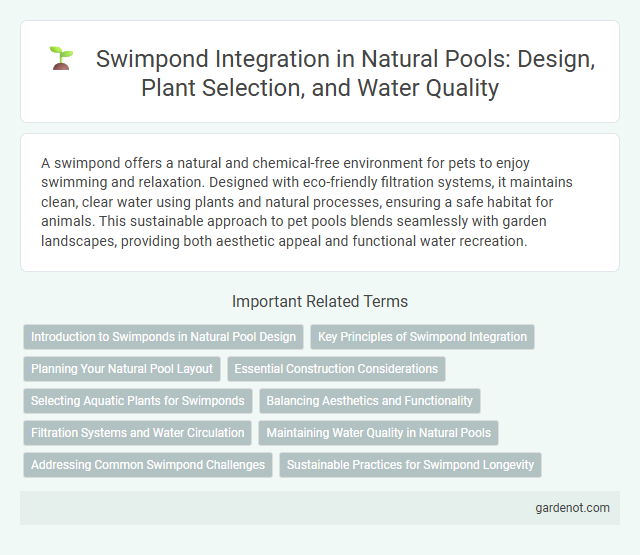A swimpond offers a natural and chemical-free environment for pets to enjoy swimming and relaxation. Designed with eco-friendly filtration systems, it maintains clean, clear water using plants and natural processes, ensuring a safe habitat for animals. This sustainable approach to pet pools blends seamlessly with garden landscapes, providing both aesthetic appeal and functional water recreation.
Introduction to Swimponds in Natural Pool Design
Swimponds integrate natural filtration systems using plants and biological processes to maintain clean, clear water without chemicals. These eco-friendly pools support aquatic ecosystems by balancing micro-organisms and nutrients, creating a sustainable swimming environment. Incorporating features like gravel filters and circulation pumps enhances water quality while blending seamlessly into natural landscapes.
Key Principles of Swimpond Integration
Swimpond integration relies on key principles such as natural filtration, ecological balance, and seamless landscape incorporation to create a sustainable aquatic environment. The use of biological filters and aquatic plants ensures water clarity while supporting biodiversity, minimizing the need for chemical treatments. Designing the swimpond with zones for swimming, regeneration, and planting maximizes functionality and aesthetic harmony within natural surroundings.
Planning Your Natural Pool Layout
Designing a Swimpond layout involves integrating natural filtration zones with swimming areas to maintain water clarity without chemicals. Careful placement of plants and circulation channels enhances oxygenation and supports a balanced ecosystem. Optimizing sunlight exposure and ensuring easy access points contribute to both aesthetic appeal and user convenience.
Essential Construction Considerations
Swimpond construction demands careful attention to natural filtration systems such as biofilters and aquatic plants to maintain water clarity without chemicals. Proper excavation with a layered substrate combining sand, gravel, and clay ensures effective water retention and microbial balance. Site orientation for optimal sunlight exposure and integration with the surrounding ecosystem enhances both usability and environmental sustainability.
Selecting Aquatic Plants for Swimponds
Selecting aquatic plants for swimponds involves choosing species that naturally filter water, enhance biodiversity, and provide habitat for beneficial microorganisms. Incorporating submerged plants like hornwort, floating species such as water lilies, and marginal plants like cattails promotes oxygenation and reduces algae growth. Proper plant selection ensures a balanced ecosystem, maintains clear water, and minimizes the need for chemical treatments in swimpond maintenance.
Balancing Aesthetics and Functionality
Swimpond designs natural pools that seamlessly blend aesthetic beauty with functional water filtration, creating an eco-friendly swimming environment free from chemicals. Their innovative biological filtration systems maintain crystal-clear water by harnessing aquatic plants and beneficial bacteria, ensuring both health safety and visual appeal. This balance supports sustainable landscaping while offering a relaxing, natural swimming experience integrated into outdoor spaces.
Filtration Systems and Water Circulation
Swimponds utilize advanced biological filtration systems that combine gravel beds and aquatic plants to naturally purify water, eliminating the need for chemicals. Efficient water circulation is maintained through pumps and strategically placed water inlets, ensuring continuous oxygenation and preventing stagnation. This eco-friendly design promotes a balanced ecosystem, supporting clear, safe swimming conditions year-round.
Maintaining Water Quality in Natural Pools
SwimPond employs advanced biological filtration systems and aquatic plants to maintain balanced water quality in natural pools, promoting crystal-clear water without chemicals. Regular monitoring of pH levels, nitrate concentration, and microbial balance ensures a healthy aquatic environment that supports both swimmers and local wildlife. Seasonal maintenance includes debris removal and restoring plant populations to optimize oxygenation and prevent algae growth in SwimPond designs.
Addressing Common Swimpond Challenges
Swimponds tackle common issues such as water clarity, algae growth, and maintenance by integrating natural filtration systems like biofilters and aquatic plants. Efficient water circulation techniques enhance oxygen levels, preventing stagnation and promoting a healthy ecosystem. Customized designs ensure balanced ecosystems that minimize chemical use and reduce the effort required for upkeep.
Sustainable Practices for Swimpond Longevity
Swimponds integrate natural filtration systems with aquatic plants and biofilters, reducing chemical usage and promoting sustainable water quality management. Utilizing renewable energy sources for pumps and employing rainwater harvesting techniques enhance the eco-friendly operation of swimponds. Regular maintenance focusing on organic waste removal and balanced biodiversity ensures swimpond longevity while preserving environmental harmony.
Swimpond Infographic

 gardenot.com
gardenot.com